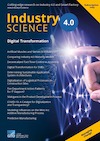Search


Bibtex
Cite as text
@Article{Gronau+Bender+Bertheau+Lauppe,
Cite-key = "Gronau2023Rob",
Year= "2023",
Number= "1",
Volume= "Industry 4.0 Science 39",
Pages= "120-125",
Journal = "Industry 4.0 Science",
Title= "Robotic Process Automation in Lieu of a New ERP System – The Reality Behind the Hype",
Author= "Norbert Gronau, Benedict Bender, Clementine Bertheau and Hannah Lauppe, University of Potsdam",
Doi= "https://doi.org/10.30844/I4SE.23.1.120",
Abstract= "Robotic Process Automation (RPA) stands for the software-supported
operation of software solutions via their user interface. The primary goal that RPA seeks to achieve is the automated execution of routine tasks that previously required human intervention. However, the potential of RPA
to improve processes in the long term is very limited. Automating processes and bridging front-end media disruptions leads to a variety of dependencies and conditions, which are summarized in this article. The path to a sustainable enterprise architecture (and the processes and systems
comprised therein) requires open, adaptive systems with modern
architecture that are characterized by a high degree of interoperability at various levels.",
Keywords= "ERP, Robotic Process Automation, RPA, process integration, automation, bot optimization, Robotic Desktop Automation,
RDA, unattended RPA, attended RPA",
}
Norbert Gronau, Benedict Bender, Clementine Bertheau and Hannah Lauppe, University of Potsdam(2023): Robotic Process Automation in Lieu of a New ERP System – The Reality Behind the Hype. Industry 4.0 Science 391(2023), S. 120-125. Online: https://doi.org/10.30844/I4SE.23.1.120 (Abgerufen 08.05.24)
Open Access
Abstract
Abstract
Robotic Process Automation (RPA) stands for the software-supported operation of software solutions via their user interface. The primary goal that RPA seeks to achieve is the automated execution of routine tasks that previously required human intervention. However, the potential of RPA to improve processes in the long term is very limited. Automating processes and bridging front-end media disruptions leads to a variety of dependencies and conditions, which are summarized in this article. The path to a sustainable enterprise architecture (and the processes and systems comprised therein) requires open, adaptive systems with modern architecture that are characterized by a high degree of interoperability at various levels.
Keywords
Schlüsselwörter
ERP, Robotic Process Automation, RPA, process integration, automation, bot optimization, Robotic Desktop Automation, RDA, unattended RPA, attended RPA
References
Referenzen
[1] Bitkom e.V. (2020). ERP und Robotic Process Automation (RPA) – Eine Einordnung.
[2] Gartner (2019). Gartner Says Worldwide Robotic Process Automation Software Market Grew 63% in 2018. URL: www.gartner.com/en/newsroom/press-releases/2019-06-24-gartner-says-worldwide-
robotic-process-automation-sof.
[3] Bitkom e.V. (2019). Robotic Process Automation (RPA) im digitalen Büro. Ein Leitfaden für Anwender.
[4] Aguirre, S.; Rodriguez, A.: (2017). Automation of a Business Process Using Robotic Process Automation (RPA): A Case Study. 4th Workshop on Engineering Applications, WEA 2017 Cartagena,
Colombia, September 27, 2017 Proceedings.
[5] Langmann, C.; Turi, D.: (2020). Robotic Process Automation (RPA) – Digitalisierung und Automatisierung von Prozessen. Voraussetzungen, Funktionsweise und Implementierung am
Beispiel des Controllings und Rechnungswesens. Springer Gabler.
[6] Syed, R.; Suriadi, S.; Adams, M.; Bandara, W.; Leemans, S.; Ouyang, C.; Ter, A.; Van de Weerd, I.; Wynn, M.; Reijers, H.: (2020). Robotic Process Automation: Contemporary themes and challenges. In: Computers in Industry: Vol. 115.
[7] Asquith, A.; Horsman, G.: (2019). Let the robots do it!–Taking a look at Robotic Process Automation and its potential application in digital forensics. In: Forensic Science International: Reports: Vol. 1.
[8] Willcocks, L. P.; Lacity, M.; Craig, A.: (2015). The IT function and robotic process automation. The Outsourcing Unit Working Paper Series (15/05). The London School of Economics and Political.

 English
English